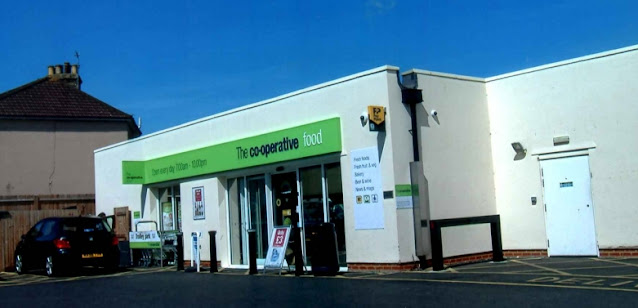 |
| copyright © D. Sharp Shelldale Road in October 2024 after the old barn was demolished on the right. |
The Name
This picturesque name is not a recent invention but a re-use of a word current in the 19th century. In 1841 it was spelt as two separate words while in 1871 it was spelt Sheldale.
The road was built on what was originally a part of the Great Shelldale farm. Elizabeth Bridger was the owner in 1797, the Bridgers owning a quantity of land in Portslade. Great Shelldale passed down to her daughter who was also called Elizabeth Bridger. In 1832 when this daughter married Thomas Thompson Cattley, her land was put in trust and Charles Bridger and Henry Colvill Bridger were tasked with the duty of managing it. The wealthy Bridger family's memorials can be seen in St Nicolas Church.
Eventually, the Bridgers sold Great Shelldale consisting of 11 acres, 1 rod and 23 perches to Abraham Peters, a Portslade farmer. On the same date as this transaction, Peters took out a mortgage for £900 on the land with John Sharp, a Southwick ship-owner. Abraham Peters was already familiar with the land because he had been farming it, having rented it for seven years on 26 February 1859 for £227.
 |
| copyright © D. Sharp Shelldale Road and the junction with Barnes Road on the right. This road was named after Joseph David Barnes who owned land west of Wolseley Road in 1897 |
Growth
According to the census of 1871 there were four families living in Shelldale, and modern development did not start until the 1920s.
In 1928 Portslade Council approved plans drawn up
by F. J. Edmonds for fifteen houses. It is interesting to note that
the next plan did not appear until 1951 and strangely enough that was
for a pigsty.
 |
| copyright © J. Middleton This nostalgic image of the old stables was taken on 19 March 2003 |
 |
| copyright © D. Sharp The old barn just after the Portslade Car Centre had vacated the premises |
 |
| copyright © D. Sharp The old barn with its slate tiles removed before demolition. |
 |
| copyright © D. Sharp May 2024, demolition in progress |
 |
| copyright © D. Sharp May 2024 |
Housing
 |
| copyright © D. Sharp The former Hartington Terrace in Shelldale Road |
The 1891 Street Directory recorded that on the north side of the road there was a terrace called Hartington Terrace numbered 1-12. The three-storied houses are still there but now numbered 15 to 29 Shelldale Road. Part of the road was declared a public highway in 1903.
 |
| copyright © D. Sharp Shelldale Road and the junction with Abinger Road, The site of the former Westup Laundry was on the opposite side of the road to the modern day Co-op. |
Albert Dudeney lived in Rose Cottage in Shelldale Road. The cottage was full of stuffed birds plus a live parrot that had pulled out most of its feathers through boredom. In addition there were several dogs.
Dudney was always to be seen wearing a Norfolk
suit and knickerbockers. He owned the laundry that stood on the
corner of Shelldale Road and Abinger Road, which was rumoured to have
been used as a smithy for many years previously. Dudney was also keen
on motor cars, and owned a Daimler, which you had to steer with a
tiller.
 |
| copyright ©
Royal Pavilion & Museums, Brighton & Hove Dudeneys would have had the same machinery as this Brighton laundry of the early 1900s |
The following article appeared in the Commercial
Motor Magazine on the 16 April 1914:-
“I am only too pleased”
says Mr. Albert Dudeney, proprietor of the Westup Laundry, 33,
Shelldale Road, Portslade, “to give your readers my experiences of
our motor-delivery facilities. The machine I use is an early Daimler,
the date of its manufacture being 1890.
I myself have had it now
for five years and three months. I use it for collecting and
delivering laundry goods, which are packed in hampers, and on some
occasions it has carried as many as 43 different baskets of linen,
and this in addition to three passengers. The machine enables my
assistants to call on 60 customers in a day, and it usually covers
about 50 miles in that period.
Before I bought the machine, I
use to have a pony-cart to deliver the articles, the cost of upkeep
of which was 12s a week, whereas I find the motor costs me but 7s.,
so that a direct financial saving is effected. In addition to this
desirable advantage, there is no horse to see to at nights or on
Sundays, consequently our men work less hours."
 |
| copyright © National Library of Australia The Dalby Herald 3 May 1935 |
First World War Heroes
 |
| copyright ©
Royal Pavilion & Museums Brighton Graphic 20 June 1916 Harry Pierce of 17 Shelldale Road |
Sadly if was not the last time that ‘17 Shelldale Road’ was the home of deep sorrow, as the next family that resided in this house also lost their son in the First World War:-
Frederick was captured at the fall of the British Garrison in Kut (present day Iraq) by Turkish forces. Frederick was then taken to a prisoner of war camp in Turkey where he sadly died of illness on 30th September 1916, aged 24. Frederick has no known grave and his name is listed on the Basra War Memorial in Iraq, it is not known why his name is not listed on the Lancing War Memorial.
David was a farm labourer by trade and lived with his parents, Alfred and Kate E Richardson at 45, Shelldale Road.
David Walter Richardson has no known grave or Naval memorial listing, but he was not forgotten in Portslade as his name is listed on the St Nicolas Church Roll of Honour and the Portslade War Memorial in Easthill Park.
 |
| copyright © D. Sharp The southern section of Eastbrook Farm Allotments in Southwick, West Sussex. |
A piece of land that had been used as allotments by Portslade Council since at least 1909 came up for auction. The land had a frontage to Shelldale Road of around 774-ft and was adjacent to Fishersgate Halt. It measured 5 acres, 1 rood and 16 poles, and by 1923 it was costing Portslade Council £24-14s a year.
In 1927 the Ministry of Health, subject to the approval of the Ministry of Agriculture, approved of Portslade Council’s plans to appropriate the remaining portion of land for use as housing.
In March 1936 it was stated that the proposed new road would involve the loss of a small portion of the side of the garden at number 56.
In 1958 planning permission was given for ten terraced houses and in 1960 for a pair of semi-detached houses on the corner of Abinger Road.
 |
| copyright © D. Sharp The western end of Shelldale Road, Portslade on the East and West Sussex Boundary where the road name changes to Manor Hall Road, Southwick. |
Co-operative Store
 |
| copyright © J. Middleton The Shelldale Road Co-op |
It seems there has been a change of heart regarding small stores where once all the talk was about superstores. In this atmosphere a small, neighbourhood Co-op was built at Portslade in Shelldale Road. It occupies a site once covered by a pub’s garden. The pub was the Gardener’s Arms in Abinger Road and although the pub has shut the building still stands.
 |
| copyright © D. Sharp Shelldale Avenue looking west from Trafalgar Road |
Second World War
 |
| copyright © G. Osborne Trafalgar Road in the 1930s, on the left is the entrance to Shelldale Avenue and in the centre is the entrance to Shelldale Road, West's Hardware Store was demolished many years later to widen Shelldale Road. |
Resident of Note
Following the outbreak of the
Second World War, the War Office re-organised the Regional Savings
Committees and launched the War Savings Campaign.
Savings Groups were
set up by volunteers in work places, schools, clubs and streets.
Miss Mary Maud Carpenter, the Honorary Collector of the Shelldale Avenue
Savings Group was awarded the British Empire Medal in January1953,
the first New Year Honours List since the accession of Queen
Elizabeth II.
 |
| copyright © Imperial War Museum
Image: IWM (Art.IWM PST 16549)
1940's War Savings Poster |
A Fire
On 2nd
October 1998 a fire broke out in the end-of-terrace council house in
Shelldale Avenue. It started in the bedroom where two young sisters
aged eight and six were sleeping. The fire destroyed everything in
the room and part of the floor fell in. As other parts of the house
were also damaged, the mother and her four daughters were obliged to
move to bed-and-breakfast accommodation.
 |
| copyright © D. Sharp Shelldale Road and the junction with the eastern entrance to Shelldale Crescent on the left. |
Sources
Argus
Census Returns
Directories
Encyclopaedia of Hove and Portslade
Mr G. Osborne
Imperial War Museum
National Library of Australia
Portslade Council Minute Books
Royal Pavilion & Museums, Brighton & Hove
Copyright ©
J.Middleton 2024
Page Design by D. Sharp